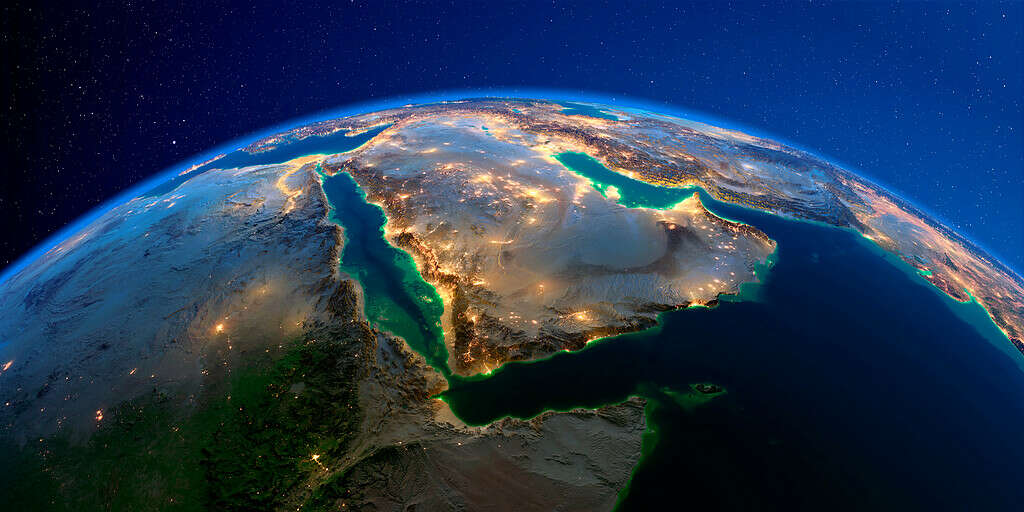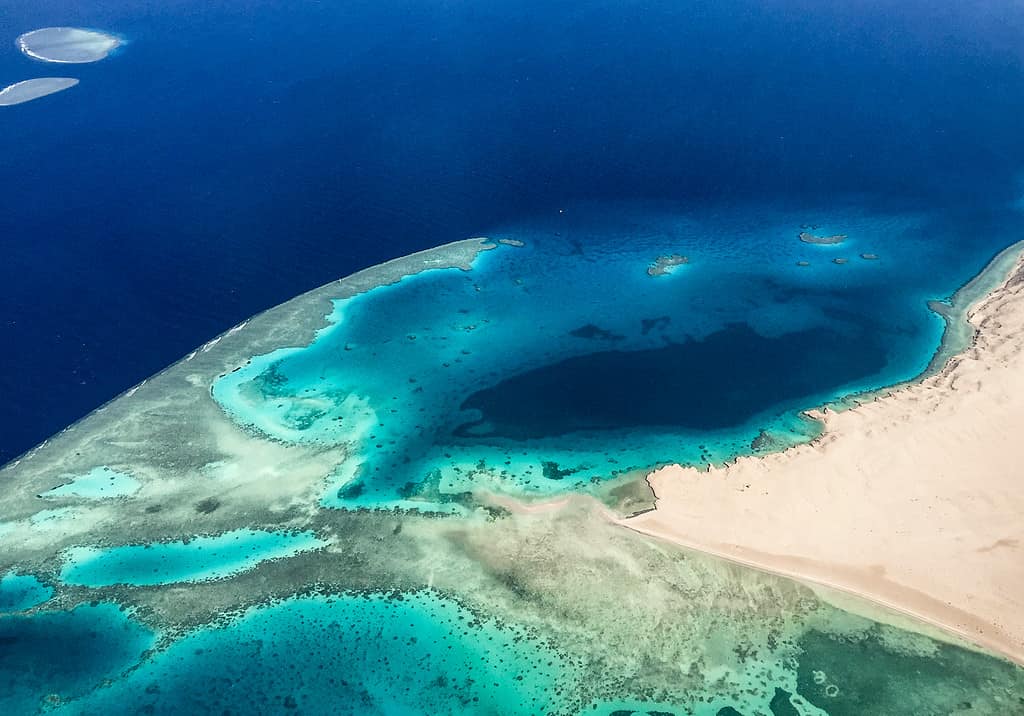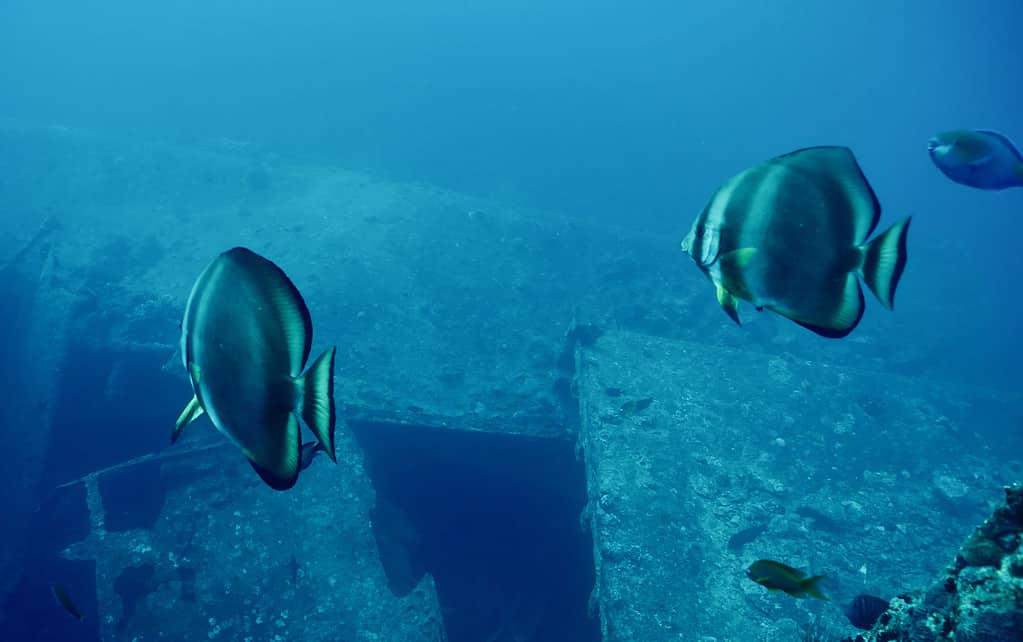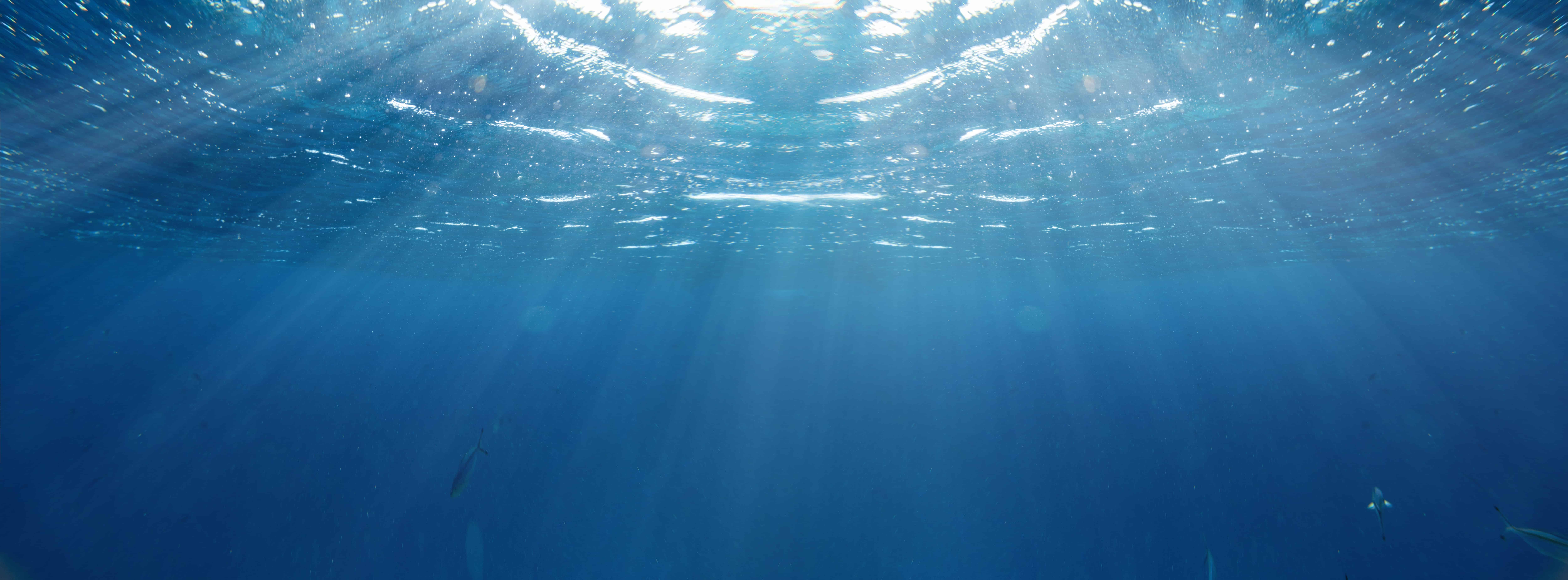The Red Sea is an inlet of the Indian Ocean between Africa and Asia. It features a surface area of around 174,000 square miles. This seawater inlet is about 1,200 miles long and around 190 miles wide at its widest point.
Six African and Asian nations border the Red Sea: Yemen and Saudi Arabia to the east, Egypt to the north and west, and Sudan, Eritrea, and Djibouti to the west.

This exaggerated relief photo taken from space shows the entire length of the Red Sea.
©Anton Balazh/Shutterstock.com
How Deep Is the Red Sea?
The depth of the Red Sea varies greatly depending on the location. The deepest point in the sea is the Suakin Trough, at 9,970 feet. The Suakin Trough is so deep and inaccessible that humans were not able to explore it until very recently. In 2020, a crew, including famed explorer Victor Vescovo, finally explored the depths of the Red Sea in a manned submersible for the first time in history.
The Suakin Trough is not indicative of the Red Sea’s depth over its entire area, though. 40% of the Red Sea is less than 330 feet deep. There are shallow shelves throughout the sea that are home to amazing corals and marine life. Taking into account these shallow shelves contrasted with the extreme depths of the Suakin Trough, the average depth of the Red Sea is about 1,608 feet.

The depth of the Red Sea varies considerably throughout its area.
©Alexandra Lande/Shutterstock.com
Where Is the Red Sea Located on a Map?
The Red Sea is a long body of water that lies between Africa and Asia. It borders Egypt, Sudan, Eritrea, and Djibouti to the west, and Saudi Arabia and Yemen to the east. It borders the Gulf of Aden to the south before it empties into the Arabian Sea.
Water Color and Salinity
The Red Sea’s waters are not red. Normally they are a lovely bluish-green. No one knows exactly where the name came from. Many suggest it is a mistranslation of the Sea of Reeds from the Hebrew Exodus narrative. Others suggest the name comes from the Trichodesmium erythraeum algal bloom, which can temporarily turn the water a reddish-brown color. No one can be certain regarding the origin of the name, though.
As the world’s northernmost tropical sea, the waters are very warm. The average water temperature is 71°F throughout the year. In the summer, the water in the northern Red Sea can measure nearly 79°F while its southern waters can register 86°F.
This warm water allows the Red Sea to host a stunning array of marine life. The sea is famous for its 175 species of nudibranch. Many of them are found nowhere else in the world. Over 250 types of coral and 1,100 fish species call these waters home. Those fish species include 44 species of sharks.
The Red Sea is not only some of the warmest sea water in the world but also some of the saltiest. The salinity of typical seawater is 3-3.5%. The salinity of the Red Sea is 36-38%. The extremely high salt content is a result of high evaporation with little precipitation or freshwater inflow. The high salt content is perfect for coral, which is why some of the most amazing coral reefs in the world are found here.

The high salinity of the Red Sea is perfect for hard and soft corals.
©iStock.com/vlad61
Shipwrecks
Along with all the living organisms in the sea, there are also numerous shipwrecks on the Red Sea’s floor. The most famous of these is the S.S. Thislegorm which was sunk by German bombers in World War II. But, unless Moses comes along, those shipwrecks are destined to remain in the depths of the Red Sea. And speaking of Moses…

These Oriculuar Spadefish are swimming above the opening in the hull of the S.S. Thistlegorm.
©iStock.com/Mark Silverstone
How Deep Was the Water During the Israelite Exodus?
The Red Sea is known by Jews and Christians as the place where the waters parted before Moses so he could lead the Israelites out of slavery in Egypt. The traditional site of this crossing in Judeo-Christian history is the Gulf of Suez. It is also the site portrayed in the 1956 epic film, The Ten Commandments.
The Gulf of Suez is the northwestern arm of the Red Sea, with Africa proper to the west and the Sinai Peninsula of Egypt to the east. While we don’t know how deep the waters may have been during the days of the Israelite Exodus, the Gulf of Suez is about 230 feet deep at its deepest point today. It has an average depth of around 130 feet.
The Gulf of Suez is a major shipping route from Egypt to the Red Sea, Arabian Sea, and the Indian Ocean. The Gulf of Suez is also the passageway for ships using the Suez Cana,l which connects the Red Sea to the Mediterranean Sea.
The importance of that canal was demonstrated in 2021 when a mega-freighter known as the Ever Given got stuck and blocked passage through the canal for six days. Supply chains around the globe broke. Losses amounted to around $10 billion in trade every day, all because one boat got stuck in one canal. It reminded the world just how important this region, the Suez Canal, and the Red Sea really are to us all.

This is an aerial shot of the southern part of the Gulf of Suez.
©iStock.com/Berezko
Thank you for reading! Have some feedback for us? Contact the AZ Animals editorial team.








